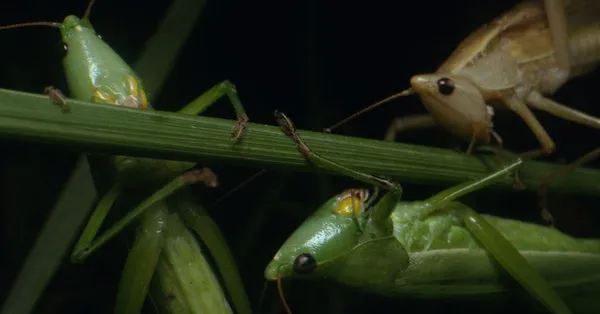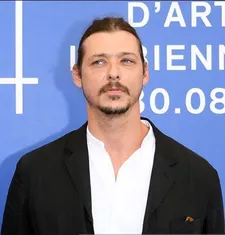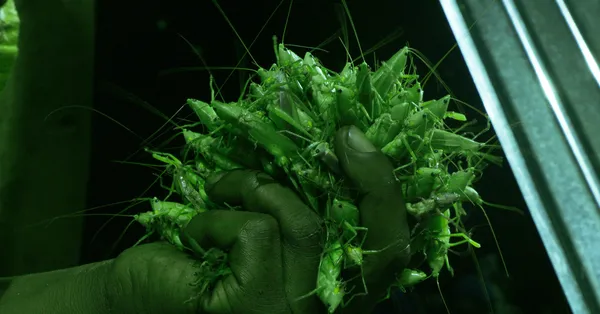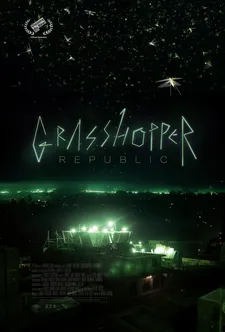 |
| Daniel McCabe on the grasshoppers: 'They're delicious. They've got a very specific and unique flavor. I'd say it's like, shrimp meets popcorn in a nutty way' Photo: Taskovski Films |
Daniel McCabe’s Grasshopper Republic opens a window into a world of commerce that few people will be aware of - the Uganda insect trade. The grasshoppers, which swarm unpredictably during one season of the year, make serious cash for those trappers lucky enough to snare them.
The American director, who previously made the documentary This Is Congo, came to the project through his friendship with Italian photographer Michele Sibiloni, who also acts as cinematographer on the film, and who had made a book about the grasshopper phenomenon previously.
McCabe explained: “During the making of This Is Congo, my previous film, I was based in eastern Congo for some years. Michele was based in Kampala, Uganda, and would travel into the Congo as a photographer and videographer working for various news organisations on different crises and conflicts in the Congo. It's a pretty small beat in eastern Congo so he and I became friends. When I passed through Uganda, we'd hang out.
“I believe the genesis of his book project was that he was riding on a bus at night, traveling to Congo where he saw this phenomenon. And he came up with the idea that he wanted to spend time documenting it and spent about seven years doing that. So over those years I'd see him here and there, and we’d clue each other in on the different projects we were working on. This was one where I was like, ‘Man, this sounds incredible. It's like a science-fiction movie or something, it feels like a film to me’. We’d kind of joke about it.
 |
| Daniel McCabe: 'My hope is that the efforts I'm making decrease the gap between worlds' Photo: Taskovski Films/Venice Film Festival |
“And then it was 2018. My film had finished and he had finished his book. We were both in France, actually, at the Prix Bayeaux War Correspondents Awards, we both had projects there. I was sitting there saying, “Man, oh, you're finishing the book, how great.You know, we should have made a movie.” And he's like, “We should have”. And our executive producer, who is one of the main funders of this, was also there. He was like, “This project sounds incredible. I'd like to get involved if you guys really want to do this”. And that's where it began.”
Sibiloni was a huge part of the project as his existing relationships helped save time when it came to the film.
McCabe says: “He was traveling throughout the entire country, because this is a nationwide phenomenon and the swarms are migratory. So they'll be in one, one city one night and a completely different one the next. In his years of work, you have to get permission from the government, earn local trust from communities and you need to have relationships with community leaders within these smaller areas. So it's by no means a situation where you can just show up in your car and then just turn on the cameras.To shoot vérité documentary, you really need to earn trust, and it's all about building that trust.
“Michele had already done all this heavy lifting. With that information, we were able to really narrow down where we were going to go that first year. Very quickly we pinpointed the city of Bundibugyo as where we wanted to look for our characters. And again, him knowing everybody within that community, all the community leaders right away, we were off to a running start.”
Having Michele’s book of photographs also helped massively.
“It could never have happened without Michele,” McCabe adds. “This isn't like a global news event, it's this kind of very small, but beautiful phenomenon. To invest the amount of time that's required to do it, that's also a really difficult thing to do. To take that effort and time and then ultimately, it translates into a budget that you need to raise to do it. It's really hard to do that on paper but when you've got a beautiful photo book, and somebody with almost a decade of hard work, it's inspirational for everybody to get involved.”
The film also proved to be something of a waiting game - as the back window of a taxi glimpsed from time to time suggests, “Patience pays”.
McCabe explains: “To put things in scope for you, we were three seasons on the ground, the seasons are about four to six weeks. So total shoot days where we were actually filming was about 100 to 110 days, which is significant for a film. Out of those 110 days, two of those days, we saw that swarm. So it's quite rare. At night, there'll be some insects and grasshoppers but the swarm you see in the end of the film, we only saw that twice in all of the three years. Then it was two nights in a row, they were just there for two nights and each night, it was about two hours that they were around. So a super-rare experience.
 |
| Grasshopper Republic. Daniel McCabe: 'No matter how protected you are there, the insects are getting in there, so it's exciting and frightening in a way'. Photo: Taskovski Films |
“And then yeah, like madness. As you can see in the film, the crowds are boiling and the money is falling from the sky. It's this celebratory moment, that's super intense, but there are bugs everywhere, crawling under your shirt. No matter how protected you are there, they're getting in there, so it's exciting and frightening in a way. But, overall the experience was a lot of waiting. It was like being in the ocean in a sailboat with no wind. To me with the fortitude and the strength and the resiliency that these trappers had, and the hope that they had that swarm is going to come was maddening and exciting.
Very little of the shoot was stage-managed, with the filmmakers preferring to work with the natural world but they did enlist the help of an entomologist for some of the macro photography.
“Our entomologist built a bit of a set actually,” says McCabe “full of grass with cage walls on all sides but the bottom, and he had captured a bunch of grasshoppers and was rearing them in there. We started witnessing mating and we were able to film that. Then we started witnessing the egg laying. Then he took the eggs and incubated them because normally the process would take about three to four months depending on the temperature and the conditions.
“These grasshoppers are very hard to cultivate so our hopes weren't very high. It wasn't until the very last night. I was convinced the eggs were dead, whether there was another day, another week, they were never gonna hatch. It was the last night. The flights were booked the next morning, the camera happened to still be out. Then we had a big crew dinner that night and we came back and they're hatching there. We just kind of just laid some graphs out on a table, got a light and filmed it and it just happened all within a few moments right on the last night. So it was definitely a Patience pays kind of film.”
The soundscape of the film is also a crucial part of its atmosphere, with Robert Aiki Aubrey Lowe’s unusual synth-driven score bringing an otherworldly feel. The musician is more associated with big fiction features like Arrival and Sicario, so I asked McCabe about it.
He says it stems from attending a concert given by Lowe, which prompted him to write to him with some clips from the film.
He adds: “Very quickly, he jumped on. It wasn't about the money for Robert, he came on because he cares about the projects he invests himself into. So we got really lucky to find somebody so switched on in this way.”
 |
| Grasshopper Republic poster Photo: Taskovski Films |
Speaking of the music itself he adds: “What I love about it is it's much more than just a score. It goes into the soundscape realm into the design of the whole sound space you're in so it fits perfectly, and I couldn't have hoped for a better collaborator.”
McCabe also emphasises how important collaboration was in every department on the film, including sound mixer António Porém Pire.
He adds: “You know, there's so many different collaborators that were so important to elevate the film to this level, which was difficult when half of your cast are trying to bite you or run away.”
Ah yes, those grasshoppers, about which McCabe says: “They're delicious. They've got a very specific and unique flavor. I'd say it's like, shrimp meets popcorn in a nutty way. There's something like 10,000 species of grasshoppers, and all of them taste different.”
That taste, he notes, is something we may all become accustomed to in the future.
“If the global population is set to double in the next 30 years, there's absolutely no way we can move forward without utilising insects as a protein source. The real thing is getting over our strange mental blocks about “gross bugs”. If you think about flesh too much, I'm sure you could gross yourself out. I learned an interesting fact along the way. We worked hand in hand with a Ugandan entomologist, who's an expert in these specific bugs. He let us know that - my numbers are [maybe not quite right] - but it's something like 35, or 40% of a cow’s body is actually usable proteinWith a grasshopper 94 or 95% is actually usable protein. They’re chopping down the Amazon to give us hamburgers, and most of that stuff's going to waste, where it's very sustainable when you look at insects as a protein resource.
“However, on the flip side of the coin, if you start trapping in in this kind of ramped up way during the reproductive cycle of grasshoppers and you're trampling on the very grasses that they're laying their eggs in, for sure there's going to be an ecosystem collapse when it comes to the grasshoppers. So we still have to be responsible as we decide to move into new protein sources. That's my hope for the film is that it raises the questions in people's minds of dance we're going to need to do not only with insects, but with anything in our lives.”
Looking to the future, like most documentarians, McCabe has “a few projects in the works”. He says: “My work, I find, is focusing more and more on man's interaction within his environment. And I'm very drawn to that.”
He adds: “My hope is that the efforts I'm making decrease the gap between worlds, whether it’s the insect world or the world between groups of people and communities orjust the world within ourselves. As we move into the future, we really do need to take long, hard looks at how we engage with our environment. And whether that's, you know, recycling more, or, you know, or paying attention to the type of foods we eat, or just being more aware of how we get to and from work”





















